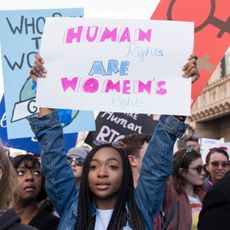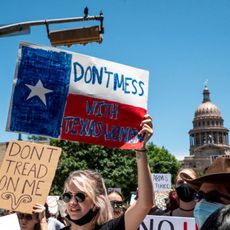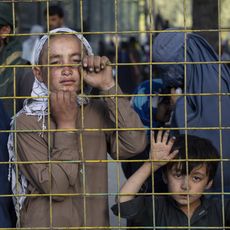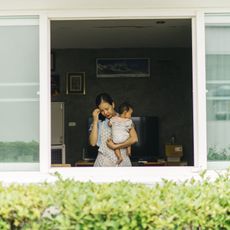

With the 25th anniversary of the Waco siege approaching, it's time to look back at the religious group at the center of the tragic incident. Here's what you need to know about the Branch Davidians.
What are the Branch Davidians?
The Branch Davidians are a religious group; an offshoot of the Davidian Seventh-day Adventist Church (which was itself an offshoot of the Seventh-day Adventist Church). The group was formed in the late 1950s under the leadership of Benjamin Roden, and was headquartered in Waco, Texas. By 1993, a man named David Koresh had risen to power within the sect.
Who was David Koresh?
David Koresh, AKA the leader of the Branch Davidians at the time of the Waco Siege, was actually born with the name Vernon Wayne Howell. He hailed from Houston, Texas, and joined the Church of Seventh-day Adventists when he was 20—but was later expelled for being a bad influence on young members.
In 1981, he joined the Branch Davidians in Waco, and began an affair with the group's leader at the time—then-prophetess Lois Roden (she was in her late sixties, while he was in his early twenties). When Lois Roden died, her son George Roden competed with Koresh for power within the group. Although Koresh eventually left Waco for eastern Texas, he took with him a small group of followers—seven of whom returned to the Branch Davidians' Mount Carmel headquarters with him in 1987, armed with rifles and shotguns. Roden was shot during the incident and Koresh and his followers were tried for attempted murder. The seven followers were acquitted and Koresh's case ended in a mistrial. He gained control of the group by 1990.

What did the Branch Davidians have to do with the Waco Siege?
The Waco Siege was was a raid of the Branch Davidians' compound in Mount Carmel, near Waco, Texas. On February 28, 1993, the group's headquarters were entered by officers from the U.S. Bureau of Alcohol, Tobacco and Firearms in response to allegations of sexual abuse and illegal weapons violations. During the course of the raid, four federal agents and multiple Branch Davidians were killed.
The siege continued for 51 days, until April 19, 1993. By the end, an additional 16 ATF agents were wounded. In addition to the Branch Davidians killed during the initial raid, over 70 more lost their lives in the final stages of the siege on April 19—when a fire erupted while agents in tanks punctured through walls in the building and used tear gas on the occupants. While some died of injuries related to the fire, others shot each other in what were speculated to be consensual suicides. Koresh died during the incident.

Were the Branch Davidians charged with any crimes?
After the final siege, nine of the surviving Branch Davidians were convicted of crimes related to the initial raid. They have all since been released from prison.
Stay In The Know
Marie Claire email subscribers get intel on fashion and beauty trends, hot-off-the-press celebrity news, and more. Sign up here.
Where are the Branch Davidians today?
According to NPR, a new Branch Davidian community has grown east of the Waco incident. The new group call themselves Branch, The Lord Our Righteousness.
"I came back here after the slaughter and I feel that the Lord has anointed me and appointed me to be the leader," Charles Pace, the group's leader as of 2013, told NPR. "I don't claim to be a prophet. I'm a teacher of righteousness, that's the only thing I claim."
RELATED STORY


Kayleigh Roberts is a freelance writer and editor with more than 10 years of professional experience. Her byline has appeared in Marie Claire, Cosmopolitan, ELLE, Harper’s Bazaar, The Atlantic, Allure, Entertainment Weekly, MTV, Bustle, Refinery29, Girls’ Life Magazine, Just Jared, and Tiger Beat, among other publications. She's a graduate of the Medill School of Journalism at Northwestern University.
-
 Clara Bow’s Great-Granddaughters React to Taylor Swift’s ’The Tortured Poets Department' Song Named After the Famous Actress
Clara Bow’s Great-Granddaughters React to Taylor Swift’s ’The Tortured Poets Department' Song Named After the Famous ActressThey “couldn’t believe” Swift named a song after the 1920s star.
By Danielle Campoamor Published
-
 Here’s How to Get Out of a Speeding Ticket, According to Zendaya and Tom Holland
Here’s How to Get Out of a Speeding Ticket, According to Zendaya and Tom HollandUnfortunately, the rest of us might not be able to use this tactic.
By Rachel Burchfield Published
-
 Fans Are Convinced Taylor Swift Gave Travis Kelce’s Dad a Shoutout on ’The Tortured Poets Department'
Fans Are Convinced Taylor Swift Gave Travis Kelce’s Dad a Shoutout on ’The Tortured Poets Department'“Oh I just know Ed Kelce is giggling and kicking his feet.”
By Danielle Campoamor Published
-
 36 Ways Women Still Aren't Equal to Men
36 Ways Women Still Aren't Equal to MenIt's just one of the many ways women still aren't equal to men.
By Brooke Knappenberger Last updated
-
 EMILY's List President Laphonza Butler Has Big Plans for the Organization
EMILY's List President Laphonza Butler Has Big Plans for the OrganizationUnder Butler's leadership, the largest resource for women in politics aims to expand Black political power and become more accessible for candidates across the nation.
By Rachel Epstein Published
-
 Want to Fight for Abortion Rights in Texas? Raise Your Voice to State Legislators
Want to Fight for Abortion Rights in Texas? Raise Your Voice to State LegislatorsEmily Cain, executive director of EMILY's List and and former Minority Leader in Maine, says that to stop the assault on reproductive rights, we need to start demanding more from our state legislatures.
By Emily Cain Published
-
 Your Abortion Questions, Answered
Your Abortion Questions, AnsweredHere, MC debunks common abortion myths you may be increasingly hearing since Texas' near-total abortion ban went into effect.
By Rachel Epstein Published
-
 The Future of Afghan Women and Girls Depends on What We Do Next
The Future of Afghan Women and Girls Depends on What We Do NextBetween the U.S. occupation and the Taliban, supporting resettlement for Afghan women and vulnerable individuals is long overdue.
By Rona Akbari Published
-
 How to Help Afghanistan Refugees and Those Who Need Aid
How to Help Afghanistan Refugees and Those Who Need AidWith the situation rapidly evolving, organizations are desperate for help.
By Katherine J. Igoe Published
-
 It’s Time to Give Domestic Workers the Protections They Deserve
It’s Time to Give Domestic Workers the Protections They DeserveThe National Domestic Workers Bill of Rights, reintroduced today, would establish a new set of standards for the people who work in our homes and take a vital step towards racial and gender equity.
By Ai-jen Poo Published
-
 The Biden Administration Announced It Will Remove the Hyde Amendment
The Biden Administration Announced It Will Remove the Hyde AmendmentThe pledge was just one of many gender equity commitments made by the administration, including the creation of the first U.S. National Action Plan on Gender-Based Violence.
By Megan DiTrolio Published